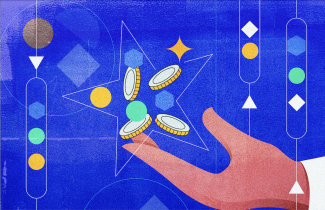The Winter of Crypto Confusion
The future of cryptoassets will be uncertain if the aim is solely to evade a regulatory framework

Even though it is summer, the precipitous drop in the price of cryptoassets over the past few weeks has cast a bleak, icy air over the fate of these alternative assets. The market value of cryptocurrencies has dropped from nearly $3 trillion USD to less than $1 trillion. In particular, the value of Bitcoin and Ethereum, which represent approximately 45% and 20% of the market, respectively, has plummeted 60% and 80%, dragging down several companies. Coinbase, one of the most important platforms to go public, boding well for the expected conjunction between Wall Street and the crypto markets, has experienced an 80% collapse. Not to mention the runs against Terra-Luna and Celsius.
The market adjustment has certainly not only impacted cryptoassets. Bond prices and stock markets have also suffered a record-breaking losses. Nevertheless, none of these traditional assets had been positioned themselves as a safe haven in the face of a crisis.
Bitcoin was created in the final stages of the 2008 Global Financial Crisis as an alternative that promised to sidestep the pitfalls of an obsolete financial system and a government inclined to issue astronomical amounts of money. Dan Morehead, CEO of Pantera Capital –one of the large cryptocurrency funds– recently stated that bitcoin had emerged from a crisis (subprime) and would come of age in another crisis (Covid-19).
Between Achaeans and Trojans, there has been a great deal of coming and going over the fate of cryptoassets. Are we close to another super rally? Have we witnessed the end of a super bubble? It's hard to reach a conclusion at this point. However, I am afraid that in these ups and downs some of the comments on this topic complicate rather than clarify the core issues to be evaluated.
On the one hand, there are the questions of economic orthodoxy that cryptoasset proponents have tried to escape, with unfortunate results. On the other, some of the critics of these assets have failed to grasp the essence of their potential. Let me explain.
Cryptocurrencies emerged in the final stages of the subprime mortgage crisis when the credibility of financial institutions and regulators was at rock bottom, and a huge injection of liquidity into the economy was being considered. The proposal to replace fiat money with a more efficient and inclusive digital medium was and is undoubtedly attractive. If, in addition, there are no over-issuance risks, even better.
Attention has often been drawn to certain limitations of cryptocurrencies, such as the number of transactions that can be processed or high energy consumption. In particular, the BIS (Bank for International Settlements) has emphasized that the high volatility of Bitcoin and other cryptocurrencies make them unattractive as a replacement for fiat money. However, none of these criticisms address the core problem of substituting fiat money backed by the Central Bank.
Can cryptocurrencies replace fiat money?
Within the framework of monetary history, the current context brings to mind the free-banking era. The main takeaway from that period, and which gave rise to the establishment of central banks under the aegis of the government, is that private currencies, even those backed by commodities such as gold or silver, are not a good foundation for a financial system. The reason for this, as seen during the Great Depression, in the Financial Crisis of 2008, and, more recently, the Covid-19 crisis, is that in highly uncertain situations a financial institution may be subject to a run or a panic if the liquidity of its assets is lower than that of its liabilities. These cases require a lender of last resort to provide liquidity for the system.
As can be imagined, a model like Bitcoin's, where supply is inelastic (capped at 21 million coins), does not have a mechanism to inject these resources into the financial sector in a timely manner. The Terra-Luna and Celsius cases reinforce this claim, since the ease with which a coin could be redeemed does not match its asset structure. Significantly, there were several comments in the market during the Terra-Luna crash that “someone” should intervene to support its value. This did not happen.
In fact, to avoid the financial panic that occurred during the Great Depression –when 9,000 banks closed in the US– or the subprime, which had a cost of approximately 498 billion dollars, institutions facing an abrupt outflow of resources must have the capacity to increase their liquidity. This capacity for monetary expansion is an extremely powerful attribute. Consequently, society should be given the opportunity to monitor the power of those who hold it and ensure that it is used in exceptional cases, without favoritism.
Hence, private currencies (digital or not) are basically not feasible. The proposal to replace fiat money with cryptocurrencies would only expose the financial system to a series of continuous runs that can be managed, as has been the case, as long as no systemic risks arise. This does not mean that currencies cannot provide useful services as a means of payment or store of value. It only suggests that, even if it were feasible, basing the monetary system on a rigid standard, be it gold or a digital asset, is undesirable.
Crypto assets and securities regulation
The second confusion in the world of crypto assets is related to securities offerings. In general, a security is an investment proposal in which the general public is invited to participate in potential profits through an undertaking. To prevent fraud and provide investors with all the elements needed to make a decision, the authorities that regulate the stock market oversee the offering process. Of course, not all investment alternatives are a security. For example, we can earn money when buying a currency such as the dollar or a commodity such as gold or oil. However, investments in these assets do not promise any return subject to a certain type of business activity.
Let’s consider, for example, the difference between investing in a barrel of oil or participating in an investment in an oil company. We could win or lose in both cases. However, investing in a barrel of oil is not a security, but investing in an oil company is. In the latter case, we depend on the management skills of third parties and, as investors, need to know their business plan and oversee their resource management.
This same distinction applies to cryptoassets. There are instruments, such as Bitcoin, which are not considered securities and many other cryptocurrencies that really do constitute a security because they depend on the business efforts of a third party. The so-called ICOs (Initial Coin Offerings) raised more than 20 billion dollars, which, owing to a lack of adequate disclosure support, produced significant losses. In this regard, digital-asset advocates need to recognize when a security offering is taking place and not evade regulation, as many issuers are currently doing. The Chair of the U.S. Securities and Exchange Commission, Gary Gensler, has placed a great deal of emphasis on this aspect, recently stating that most of the tokens being traded fall within the definition of an investment instrument. In consequence, fines reaching hundreds of millions of dollars have been imposed to eradicate this harmful market practice.
What is the future of crypto?
The future of cryptoassets will be uncertain if the aim is solely to evade a regulatory framework that, despite its limitations, has demonstrated its raison d’être through the painful experiences of financial crises and breaches of trust. The role of central banks as the mainstay of stability in the financial sector, beyond their responsibility to control inflation,and of the Securities Commissions as overseers of investment transactions between individuals must be appreciated by the new generations of cryptonauts and demanded by society.
The limitations that we have already described seem to be sufficient to bring the case of cryptoassets to an end. But this is not true. The blockchain technology that supports cryptoassets shows great promise for addressing the challenges of a digital market economy. The impact of digitization on efficiency has been plain since the Covid-19 crisis. However, there are two minimum conditions that must be met to drive a digital market economy: having a digital representation of scarcity(property rights) and fostering decentralization.
The importance of scarcity and decentralization in a digital economy
Brian Armstrong, CEO of Coinbase, offered a clear explanation of the relationship between blockchain and the concept of digital scarcity: “Sending value digitally without intermediaries has long been impractical. For example, once a picture is digital, it can be copied millions of times instantly. Once something is infinitely replicable, it loses its value, making the digital format ill-suited for storing or transmitting value. The foundational innovation of blockchain technology was to bring uniqueness and scarcity into the digital realm…Bitcoin sparked a revolution by proving the ability to create digital scarcity: a unique and finite digital asset whose ownership could be proven with certainty.” One of the driving forces of the propagation of NFTs (Non-Fungible Tokens), which emerged in the field of arts and collecting, was precisely the need to perfect the mechanism of property rights in a digital world.
However, being able to make scarcity or property rights operational is a necessary –though insufficient– condition to drive a digital economy. We need further to pursue a decentralized system.
Not long ago, I heard on a well-known podcast the statement that blockchain has no future in the development of the financial system because all the activities could be replicated more efficiently in a database. This statement is a restatementof the claim that an economy works best through centralization. Given the evident cycles of the market economy, the desire, the aim, to replace the market system with a more rational and orderly system (such as a database) is recurrent. However, in practice, centralized systems –as clearly shown in the collapse of socialist economies– are not that efficient. The principles of innovation and entrepreneurship that have marked the great milestones of progress in the most developed economies have occurred in market environments. The reason for this is precisely decentralization. The market provides the signals for countless people to endeavor to provide a solution. If access to the database is controlled by an elite few, this innovation becomes petrified. Hence, the potential of Web 3.0 has been linked to blockchain technologies.
Although we cannot guarantee the future of cryptoassets, they represent one of the most immediate tools for responding to the challenges of a digital market economy. In fact, despite the debacle in the cryptoasset market, investment amounts are still substantial. In the first quarter of 2022, venture capital funds invested a record-breaking over 10 billion dollars in companies from the sector. In particular, with potential in the capital market, where information asymmetry problems prevail, these instruments can democratize access to financing, stimulate investment in innovation, and avoid greenwashing to encourage truly sustainable investments. Hopefully, with a better understanding of the reason for regulation and its raison d’être in a market economy, the sector will mature and unleash its potential.
The author is Full-time Professor at EGADE Business School.



